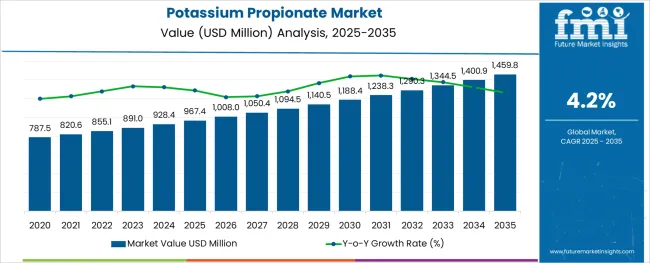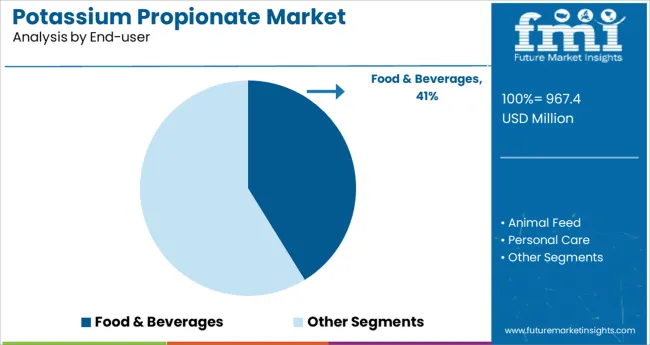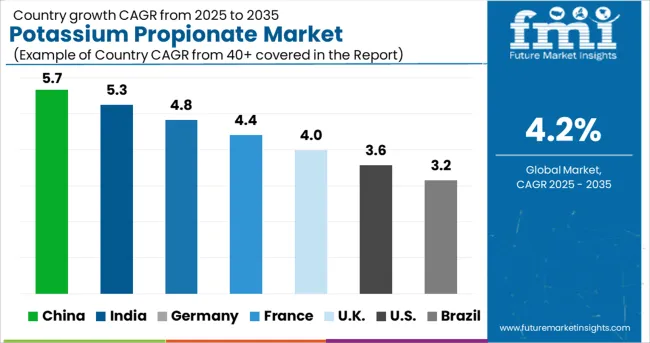The Potassium Propionate Market is estimated to be valued at USD 967.4 million in 2025 and is projected to reach USD 1,459.8 million by 2035, registering a compound annual growth rate (CAGR) of 4.2% over the forecast period.

The potassium propionate market is exhibiting steady growth, fueled by rising demand for effective and safe food preservatives aligned with global food safety and shelf-life requirements. Regulatory encouragement toward reducing synthetic additives and increasing adoption of propionate-based solutions in processed food production have been supporting the market’s momentum.
Producers are focusing on developing high-purity, cost-efficient formulations that meet evolving industry standards while addressing consumer preferences for clean-label ingredients. Future expansion is expected to be supported by growing consumption of packaged food, heightened awareness of foodborne spoilage prevention, and strategic collaborations between ingredient manufacturers and food brands.
Advances in production technologies and distribution strategies are paving the way for stronger penetration into both developed and emerging markets, ensuring long-term sustainability of growth.
The market is segmented by End-user, Application, and Distribution Channel and region. By End-user, the market is divided into Food & Beverages, Animal Feed, Personal Care, Pesticides, and Others. In terms of Application, the market is classified into Food preservative, Mold inhibitor, Antimicrobial agents, Fungicides, and Flavoring. Based on Distribution Channel, the market is segmented into Hypermarket/Supermarket, Convenience Store, Online, and Direct Selling. Regionally, the market is classified into North America, Latin America, Western Europe, Eastern Europe, Balkan & Baltic Countries, Russia & Belarus, Central Asia, East Asia, South Asia & Pacific, and the Middle East & Africa.

When segmented by end user, the food and beverages segment is projected to hold 41.2% of the market revenue in 2025, establishing itself as the dominant domain. This leadership is attributed to the pervasive use of potassium propionate as a preservative in bakery, confectionery, dairy, and other processed food products where microbial spoilage poses significant risk.
Companies in this sector have prioritized the use of propionate-based solutions to meet stringent shelf-life requirements without compromising product quality or taste. The ability to comply with clean-label demands while maintaining functional efficacy has enhanced adoption across major production facilities.
Large-scale production volumes, strict regulatory compliance needs, and growing consumer demand for safer, longer-lasting food products have collectively reinforced the dominance of the food and beverages segment in this market.

In terms of application, the food preservative segment is expected to account for 38.7% of the total revenue in 2025, making it the leading application. This position has been supported by the proven antimicrobial properties of potassium propionate, which effectively inhibits mold and bacterial growth in various food matrices.
Industry practices have increasingly shifted toward propionate solutions as alternatives to older preservatives, driven by their favorable safety profile and compatibility with a wide range of food formulations. Production processes have been optimized to ensure consistent quality and performance, further encouraging their use at scale.
Continuous innovation in application techniques and the ability to meet diverse regulatory standards have strengthened the food preservative segment’s leadership, ensuring its centrality in the potassium propionate market.

Segmented by distribution channel, the hypermarket and supermarket segment is forecast to capture 36.5% of the market revenue in 2025, solidifying its leading role. This dominance stems from the high visibility, accessibility, and trust consumers place in these retail formats when purchasing packaged and preserved food products.
Retailers have been actively promoting products containing potassium propionate by emphasizing their safety and shelf-life benefits through in-store promotions and clear labeling. The ability to cater to mass-market needs with consistent availability and competitive pricing has enabled hypermarkets and supermarkets to maintain a strong hold over consumer purchasing preferences.
Additionally, the scale and efficiency of their distribution networks have supported widespread market penetration, reinforcing their leadership in delivering potassium propionate-based products to end consumers.
Manufacturers are constantly concentrating their efforts on new innovations to meet consumer demand for high-tech ingredients as the food industry becomes more competitive. Food preservatives give producers a flexible base from which to expand their product lines. They are an essential part of food processing.
Preservatives come in both natural and artificial forms. In the few permissible quantities in food products, propionates are frequently used as preservatives.
Propionic acid's potassium salts are known as potassium propionates. Due to propionic acid being its active component, potassium propionate is a fatty acid preservative. To extend the shelf life of bakery products, potassium propionate is frequently used. The amount of potassium propionate that can be used in baked goods is 0.3%.
Potassium propionate is utilized as an anti-roping and anti-molding agent in addition to bakery products. In addition to being created chemically, potassium propionate can indeed be obtained naturally from food that has been fermented by bacteria, like Swiss cheese.
A new report published by Future market insights, titled, Potassium Propionate Market-Global Opportunity Analysis and Industry Forecast, 2025 to 2035,projects the global Potassium Propionate market to reach USD 1,344.4 million by 2035 and is expected to grow at a CAGR of 4.20% from 2025 to 2035.

The market for potassium propionate is dominated by North America. The usage of potassium propionate is anticipated to rise in North America with the increased intake of processed and frozen foods. Potassium propionate is expected to grow in popularity in the Asia-Pacific region. Australia is thought to hold a significant portion of the market in the Asia Pacific region due to its highest permissible limit for preservative use.
Providing a business opportunity for producers of potassium propionate. A large portion of the potassium propionate market is also produced in Europe due to the rising use of food preservatives.
Potassium propionate is a naturally-occurring preservative used to extend shelf life and reduce microbial spoiling in a variety of food products, from cheese to condiments. With the growing worldwide demand for food safety and quality control, the global market for potassium propionate is expected to expand significantly over the next decade. But what does this mean for North America?
As one of the largest markets for potassium propionate, North America stands to benefit greatly from its growing popularity. With its established infrastructure and access to large amounts of raw materials, many experts believe that North America may be able to gain a significant share in this highly competitive market. Furthermore, as more companies become aware of potassium propionate’s many benefits, they will likely begin utilizing it more frequently in their own products-leading to an even bigger uptake across the region.
Consumers are gravitating toward convenient food options like processed and canned foods as a result of changing lifestyles. As a result, the market for potassium propionate as a food preservative is expected to grow. Potassium propionate's preservative qualities help extend food's shelf life and preserve its quality over an extended period of time.
The antimicrobial properties of potassium propionate prevent microorganisms from proliferating by delaying their acidification process. thereby avoiding food product contamination. Consequently, the market for potassium propionate has been expanding. In addition to having antimicrobial qualities, it also aids in preventing mold growth in animal feed.
Instead of stopping the growth of bacteria, potassium propionate works better at stopping the growth of fungi therefore, potassium propionate is regarded as the preferred option among bakery manufacturers. Potassium propionate is used as a raw material in the production of plastic and fragrances.
As consumers gravitate toward products made from natural sources. Given that potassium propionate is also accessible in synthetic form, this could impede the market growth. Additionally, artificial preservatives are linked to health risks. Additionally, potassium propionate has a number of negative side effects, including the potential to impair the immune and digestive systems as well as cause neurotoxicity in children when taken in large doses.
The Potassium Propionate in the market is expected to grow at a CAGR of 4.20% during the forecast period of 2025 to 2035. The growth of potassium propionate in the market is being driven by both supermarket and industrial distributors. This chemical compound, also known as potassium salt, is used for a variety of applications including food preservation, pharmaceuticals, and animal feed.
Potassium propionate has seen an increase in demand from supermarkets and industrial distributors due to its effectiveness as a preservative ingredient for a wide range of products such as bakery items, canned goods, meats, milk products, pet food, and other processed foods.
Industrial distributors have also been an important factor in the growth of the potassium propionate market due to their use in various industries ranging from textiles to paints and coatings. It can be used as an adhesive binder or stabilizer for paints or coatings which helps maintain color consistency during storage and transportation.
| Attribute | Details |
|---|---|
| Forecast Period | 2025 to 2035 |
| Historical Data Available for | 2020 to 2025 |
| Market Analysis | USD million for Value and Units for Volume |
| Key Regions Covered |
North America; Latin America; Europe; Asia Pacific; Oceania; Middle East and Africa (MEA) |
| Key Countries Covered |
USA, Canada, Mexico, Germany, United Kingdom, France, Italy, Spain, China, Japan, India, South Korea, Australia, Brazil, Argentina, South Africa, UAE |
| Key Segments Covered |
By Application, By End-user, By Region, By Distribution Channel |
| Key Companies Profiled |
Triveni Chemicals; Sigma-Aldrich Co.LLC.; A.M Food Chemical Co., Limited.; Aadhunik Industries; HJTEC International Limited; Tokyo Chemical Industry Co., Ltd. (TCI) |
| Report Coverage | Market Forecast, Company Share Analysis, Competitive Landscape, DROT Analysis, Market Dynamics and Challenges, and Strategic Growth Initiatives |
| Customization & Pricing | Available upon Request |
The global potassium propionate market is estimated to be valued at USD 967.4 million in 2025.
It is projected to reach USD 1,459.8 million by 2035.
The market is expected to grow at a 4.2% CAGR between 2025 and 2035.
The key product types are food & beverages, animal feed, personal care, pesticides and others.
food preservative segment is expected to dominate with a 38.7% industry share in 2025.
Explore Similar Insights

Thank you!
You will receive an email from our Business Development Manager. Please be sure to check your SPAM/JUNK folder too.